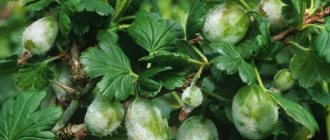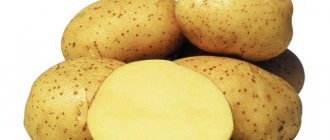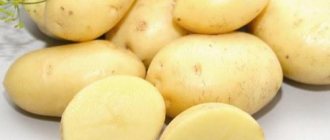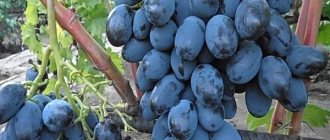Single-clove garlic - what kind of variety is it?
Some gardeners are mistaken in thinking that one-toothed is a special variety. This is a misconception. One-toed or so-called sowing is seed material that can be obtained from any bolting varieties.
For cultivation, 2 types of material are used:
- Cloves from a head of garlic. When grown, the usual heads are obtained.
- Bulbs. Small aerial seeds obtained from inflorescences. One-toothed mushrooms are grown from them. This set, growing, forms marketable garlic of very good quality.
When large bulbs are planted in the fall, they grow into a full-fledged set consisting of one clove the very next year. This is how single clove garlic is obtained.
Reference
Other names are: monocotyledon, one-toothed and set.
These bulbs can be called elite reproductive planting material.
Garlic seeds are bulbs
This culture is designed in such a way that garlic seeds are not actually cloves, which are usually buried back in the ground, but something else that forms on the stem of the so-called “arrow” after flowering. The airy bulbs of garlic are usually removed during the formation of the “arrow”. They interfere with the ripening of the heads, so it is important to break them out in time. But a few are worth keeping.
It is important to know how many bulbs there are in garlic in order to plan in advance the planting of healthy seed material. So, there are about 80 buds in one inflorescence. Not everyone gives a bulb. Most often, about half of the full-fledged, ripened seeds remain. Those. in one “arrow” there are 40 – 50 bulbs. If you plan to plant in the fall, remember that approximately 30% of the seeds freeze in the winter. Those. 35 pieces remain. Until spring, approximately the same number of viable seeds will remain in an apartment. If you plan to get 100 pieces of one-toothed ones with updated genetic qualities, then leave 3 “arrows” for the seeds.
Appearance
The single tooth (set) contains only one clove, which is where it gets its name. It is a rounded, slightly elongated tooth.
Unlike the usual curved clove from the head, the single-claw is rounded on all sides, and has the appearance of a drop flattened at the top and bottom.
Weight ranges from 1 to 5 grams, size for planting from 10 to 20 mm, depending on the variety and growing conditions. Planting material larger than 20 mm in size is considered elite and is used for growing exhibition plant specimens.
How is it different from other types of planting materials?
Garlic planting material is bulbs, cloves and single cloves. They have significant differences among themselves.
Bulbs are used only for growing sets. Obtained from the air pods on the shoots of the plant. Bulbs allow you to obtain rejuvenated commercial garlic without characteristic diseases in the second year.
Teeth. This is ordinary garlic that is eaten. When planting with cloves, the garlic head is peeled. The seeding material is the resulting cloves. Planted in autumn or spring and get a full harvest.
One-tooth (set) is an excellent planting material that allows you to rejuvenate plants, preserve the characteristics of the variety, increase resistance to diseases and get a better harvest.
Botanical features of single clove garlic
Single clove garlic is grown from seed material obtained as a result of flowering of the vegetable crop. Small aerial bulbs, falling into the soil, grow in one season into a large bulb, which is not divided into individual cloves. Due to the presence of only one clove, the culture got its name.
To grow single-clove garlic, both the winter method of planting in open ground and the spring method are used.
Appearance
One-toothed is a round onion, with one large clove of a slightly flattened shape. One-tooth bulbs differ in size and are divided into classes. The color of the bulb, depending on the variety, ranges from white to light purple. The shell is dense, multi-layered.
The weight of the bulb, depending on the variety, is from 1.5 to 6 g, the optimal size of planting material is 10-20 mm. If the bulb is larger in diameter, it is considered an elite seedling.
Important! By planting such bulbs, already in the first season you get full-fledged heads of garlic with multiple cloves.
Pros and cons of the decision to plant one-toothed trees
The negative aspects are the laboriousness of the process, the duration of receipt, and when purchasing, the cost of the seeds. But all of them are insignificant compared to the benefits received.
The positive aspects of growing appear already during planting. The seedlings do not need to be carefully placed at the bottom of the furrows; they are very well oriented during germination. Takes root quickly. The roots grow evenly along the entire bottom and pull the one-toothed tree vertically into the ground.
In addition, it overwinters well, grows well and is not susceptible to disease. It grows in large heads of the same shape with a large number of thick teeth. Preserves the best varietal characteristics. The result is an excellent yield, usually higher than from cloves.
Harvesting single tooth
Single clove garlic is harvested when the tips of the leaves begin to turn yellow and the feathers begin to lie down.
It is dangerous to be late in harvesting - the leaves dry out quickly, and the head goes into the ground, making it difficult to pick it out. Gardeners say that it is better to under-expose garlic in the ground than to over-expose it - ripening can be completed even after uprooting.
The approximate harvesting time for the one-toothed tree is mid-to-late July. To check, remove a couple of heads from the soil - they should be firm and well developed.
It is better to dig garlic with a pitchfork. Pry up a clod of earth with a bulb, pick it out of the soil with your hand. Spread the dug plants along the length of the bed for several hours without cutting off the leaves, then dry it in the attic or under a canopy.
Expert opinion
Yulia Safronenko
Big fan of experiments and personal gardening techniques
Ask a Question
Garlic left in the sun for a long time “glazes,” so do not leave it in the garden in the heat.
After drying the crop, crush the stem, cut off the roots and store it in a dry, dark place with good ventilation.
What varieties can be sown this way?
All varieties that shoot arrows are suitable for growing crops by planting sets. There are a lot of them. These are mid-season varieties Alcor, Promin, Sofievsky, German, Nadezhny, Replicant, and early-ripening Lyubasha.
Separately, it is worth noting the winter garlic Lyubasha. This is an early ripening, frost-tolerant, drought-resistant variety. Resistant to diseases. The heads are large in size, approximately 120 grams each, and store well. Productivity is high. Ideal for growing in central Russia and the south.
What to do if garlic, planted for the winter, begins to sprout (sprout)
It happens that after planting before winter, warm weather suddenly sets in and the garlic begins to grow. Should we be afraid of this and what should we do if this happens? If the height of the shoots does not exceed 5 cm from ground level, then you have nothing to worry about. The plant is cold-resistant and will overwinter well, but if the plant has grown much larger, take measures to provide additional shelter from frost. Cover with a layer of hay, straw, spruce branches. You may lose some of the plants, but not all. For the future, remember that winter garlic is not planted before October. Watch another video on this topic.
That's all for me. I believe that the harvest grown in the garden or vegetable garden will never disappoint you. Well, I say goodbye, see you at the plot.
Sincerely, Alexander
Boarding time
Winter garlic is usually planted in late September or early October. In the northern regions and with the early onset of cold weather, planting is possible at the end of August. The optimal time for planting is when the top layer of soil cools to 10-12 °C.
Important!
The planted winter seed must have time to take root; this will allow it to overwinter well and will guarantee a high harvest.
Spring planting occurs with the beginning of field work, which varies by region. Garlic is resistant to cold and begins to take root already at a soil temperature of about +2 °C.
Reference
The winter variety is more productive, ripens two to three weeks earlier, and is stored well until January. Spring is less productive, but is stored longer.
An alternative way to plant winter garlic
There is another, less usual approach to preparing a bed for winter garlic.
We apply fertilizers for planting garlic
At the end of August, it is necessary to apply fertilizer to the garden bed:
- potassium sulfate (2 tbsp per sq.m.);
- superphosphate (1 tbsp per sq.m.);
- wood ash (2 cups per sq.m.);
- chalk (1 cup per square meter);
- humus (10 kg per sq.m.).
All fertilizers are applied dry and scattered over the soil surface.
We cultivate the soil
After this, the ground must be thoroughly dug up. Again, to speed up shrinkage, water the soil generously. If the weather is rainy, watering is not necessary.
Filling the bed
First of all, along the prepared bed, 35-45 cm from it, you need to sow rows of peas, oats and white mustard.
We cultivate the soil before planting
1-2 days before planting garlic, it is necessary to apply fertilizing. To do this, urea is added to the beds (10-20 g per sq.m.). Then the ground is generously watered.
Planting winter garlic
In early October, when the sprouts of peas and oats reach 20 cm or more, it is time to plant garlic between their green rows.
This method of winter planting garlic is quite effective. The greens will retain snow in the beds, so that in winter the garlic will be covered with a snow coat, and in the spring it will receive sufficient moisture.
Whatever technology for planting and growing winter garlic you choose, we hope you will be able to get a good harvest next summer.
Source
How to grow
Usually the one-toothed one is planted in the fall and dug up the following year. Care for it like regular winter garlic. For various reasons, you can miss the planting date and the seeds will remain idle. It's OK. One-tooth can also be planted in the spring, taking into account the weather forecast.
It is important to germinate it before planting. Otherwise, the set may not have time to form a head of cloves and will grow into a large single-clawed one.
Pre-planting preparation, planting, care and harvesting are carried out in the following order:
- In the fall, before plowing or digging the soil, it is necessary to apply fertilizers. Up to half a ton of aged manure or compost, 500 g of superphosphate and 300 g of potassium salt per hundred square meters.
- A month before planting, the one-tooth must be soaked in a growth-stimulating solution from Rostock, Biomaster or other stimulants. The next day, wrap it in cotton cloth and put it in plastic bags to prevent drying out. Place in a refrigerator with a temperature of approximately plus 5 °C. After four weeks, the seeds should grow roots up to 1 centimeter.
- Plant at the beginning of field work, at a soil temperature of at least plus 2 °C. Carefully, so as not to damage the roots, insert the bulbs into the furrows to a depth of 5 - 6 cm. Row spacing is 40 - 45 cm, rows with an interval of about 8 cm.
- After emergence, fertilizing with ammonium nitrate is necessary. Scatter dry saltpeter under watering and mulch with peat or humus.
- At the beginning of summer, you can feed with an ammonia solution at the rate of 2 ml of ammonia per liter of water, and complex fertilizers.
- Basic care consists of timely watering, loosening and weeding.
- The crop is harvested in September, when the plant stems lay down. Dry under a canopy or in a dry room for a month, then sort through.
- It is better to store spring garlic at a temperature of 16 to 20 °C in a dark, dry room.
Crop care
If you planted winter bulbs, make sure that there is always enough snow in the beds. If the zama has little snow, rake all possible snow onto the garlic plantings using a shovel. This will allow the spice to sprout early.
If spring (especially May) is dry, the beds need watering, always 1-2 times a month.
How to feed crops:
- end of March - beginning of April - fertilizing with nitrophoska (15 g per 1 sq. m.);
- the first 5 days of June - fertilizing with ammophos (15 g per 1 sq. m.) and wood ash (5-6 cups per 10 sq. m.).
Read more in our other article: How to feed garlic?
Arrows that have grown to 5-8 cm must be carefully cut off or broken off under the third leaf - they reduce the yield.
Also see the article on the topic: Why does garlic turn yellow in spring: what to do?
Diseases and pests
Garlic is often planted as an insecticide to protect other plants from pests. Despite this property, he himself often suffers from diseases and pests.
Most often it is affected by the following diseases:
- Fusarium.
- Bacterial rot.
- Downy mildew.
- Rust.
- Black mold.
Common pests do not bypass garlic:
- The most common, harmful and dangerous is the stem nematode. Loves plant juice. Eating it damages the stems. This inhibits growth and leads to damage to the heads.
- Onion moths can also damage garlic. Lays larvae on stems. Small worms emerging from them feed on the leaves, which slows down the growth of plants.
- Another fan of eating garlic leaves is the Onion Secretive Proboscis. A small beetle, eating the stems, forms cavities in them. The plant withers and may die.
- The onion root mite can damage the roots of plants. This pest, by damaging the roots, deprives the plant of moisture and also provokes the manifestation of fusarium.
Plants are susceptible to diseases if they are grown with improper soil tillage, crop rotation is disrupted, and untreated and contaminated planting material is used.
What are the advantages and disadvantages of growing
Many gardeners wonder why complicate life, and grow garlic from aerial seeds; it is easier to plant ordinary cloves of any variety of vegetable crop. But it is from the one-toothed plant that a high-quality and large harvest of vegetables is obtained. Garlic propagated from aerial bulbs is distinguished by its natural immunity to diseases, pests and unpretentiousness to climatic conditions and soil composition.
The main advantages of the single-tooth blade:
- The seed material quickly takes root in the soil and allows you to grow a good harvest of garlic already in the first planting season.
- The garlic bulb is not divided before planting in open ground.
- Vegetables grown from aerial bulbs rejuvenate your favorite varieties of garlic.
- The seed material is resistant to frost, diseases and pests.
The disadvantage of single-clove garlic is the high price of planting material and the time it takes to obtain a full-fledged bulb with a large number of cloves.
Problems during cultivation
There are no special problems when growing single-toothed. It is necessary to follow the rules of agricultural technology, plant in a timely manner and properly care for them. But to get good results, you need to take into account some nuances of storage before planting. When dug out of the ground, the one-toothed fish, if maintained at an acceptable temperature, is in a state of rest. The optimal temperature is 5 - 10 °C. The best place would be a dry, ventilated room. Stores well in boxes with a capacity of up to 10 liters with holes or in a low mound on ventilated racks. There is no escape from natural decline. It can increase if the teeth are dug out at the wrong time.
Growing garlic from single cloves when planted in spring is problematic. It may not have time to divide into cloves, and the head will not form. One, but large clove may grow, which has no marketable appearance and is only suitable for processing.











